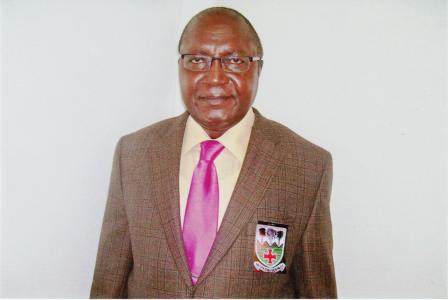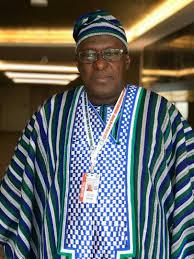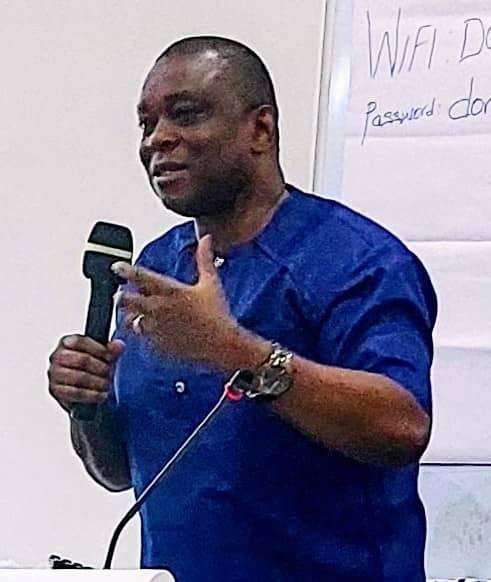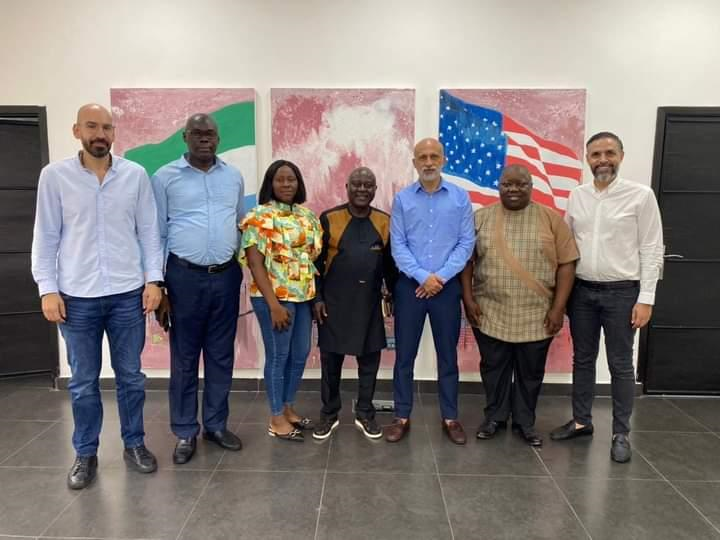From Cline Town to Mount Aureol: (Fourah Bay College 188th Anniversary)
To coincide with the 188th Anniversary of the founding of Fourah Bay College on the 18th February 2015, a new edition of Fourah Bay College history “From Clinetown to Mount Aureol, Fourah Bay College 1827 to Present” has been published in Canada. The author, Anthony Karim Kamara Sr., (in photo) four years earlier in 2011 also published his first history on Fourah Bay College, “ A Concise History of Fourah Bay College 1827 to 2003.”
From Clinetown to Mount Aureol, with a Forward written by Dr Abdulai O. Conteh, one time Attorney General and Minister of Justice, later Foreign Minister and Minister of Finance and Acting Vice President of Sierra Leone, is a lucid historical narrative of the difficult and tumultuous path along which Fourah Bay College travelled from a Christian Institution to a University College in Cline Town to today’s University College towering above the city of Freetown; it is also a catalogue of the untold history of Fourah Bay College, the very first effort by a British Christian philanthropist group, the Church Missionary Society (CMS) at introducing western education and western ideas into West Africa from its nascent stage to its checkered growth into the expansive university college more popularly identified globally as the ‘Athens of West Africa’. It is the nucleus of today’s University of Sierra Leone atop Mount Aureol. The CMS aim was to bring Western education and ideas along with the message of Christianity to the heathen peoples of Africa to atone for the evils of the Slave trade which devastated the continent and lasted for almost three centuries causing the huge depopulation of Africa. The treatment of the Colonial administration towards this first university institution is sad to narrate, but the world and West Africans in particular deserve to know the history, the story of a callous, snobbish and contemptuous European imperialist. When the reader goes through this history, the conclusion is that, we can never forgive the British for opposing the introduction of Western Education to our native land and the vicious tactics employed to thwart the CMS hopes.
Fourah Bay College, starting with six foundation students on the 18th February 1827. including the legendary Yoruba boy Samuel Ajayi Crowther has a student population today of over 5,000. The story of this parent University College is one of a struggle for survival against the British colonial administration’s apathy and overt aversion towards the Institution’s existence as a Higher Institution of learning. This publication includes the names of the six students enrolled on Inauguration Day on the 18th February 1827 as the Foundation students of the new Institution. Britain, the colonial master never disguised her repugnance to the CMS efforts at introducing Western education and western ideas to this country and the sub region in general believing that the African was too backward a race to be introduced to European ideas and saw it as a waste of time . For the CMS intransigence to go it alone, the British colonial administration deliberately denied any financial incentive whatsoever to the indigent CMS owners who did their utmost to singlehandedly struggle to make the project a success.
Fourah Bay College is the first English speaking University Institution in tropical Africa south of the Sahara with roots in Freetown and seconded only by the University of Cape Town (1829) in South Africa and even much older than Britain’s University of London established in 1836. It was as a result of British opposition that encouraged the CMS to employ the services of Germans like Edward Bickersteth, Leopold Butscher as first and second principals of the failed Christian Institution respectively. A total of nine German Nationals became administrators of Fourah Bay College between 1827 and 1923. The list of FBC principals can be found in Chapter 17 of the book.
This publication tells the entire story as it is, to dispel the old misconceived ideas by West Africans and Sierra Leoneans in particular that Fourah Bay College was started by the British Colonial administration. On the contrary this was never the case and this was attested by the fact that since 1807 when Sierra Leone was declared the first British Crown Colony in West Africa, it was not until 98 years later in 1906 that the colonial administration started their very first school in Sierra Leone, the Bo government Primary school for sons and nominees of Chiefs to create a body of faithful servants in their colonial economic exploitation of the country through their Policy of Indirect Rule and it took the Colonial administration some 30 years before the school was upgraded first into a Junior secondary school in 1936 when it started sending students for what was known as the Junior Cambridge examinations (or Junior Cantab) and four years later in 1940 further upgraded into full-fledged secondary school and started sending students for the former Senior Cambridge School examinations (or Senior Cantab). The British were initially interested in providing only some elementary education to those who attended the Bo Government School, persons they wanted to be partners in their Indirect Rule and encouraged to be content with traditional and rural life and leadership of their peoples and not try to imbibe foreign ideas that would make them feel superior to their peoples. The products of this school were to remain with their peoples in the rural areas.
As Fourah Bay College was started without British support, the first attempt to terminate its existence was at the outbreak of the European war of 1914-1918 when the Colonial administration evicted the College from its Clinetown Campus and temporarily relocated it to the Battenberg Memorial School in Central Freetown (later known as the Diocesan Technical Institute), to make room for 250 German Prisoners of War (POWs). After eight months in temporary exile, the students were allowed back to their campus in Clinetown when the 250 Prisoners of War (POWs) were transferred to Britain.
In short Fourah Bay College from its early beginnings as a Christian Institution in Leicester and later Regent to its upgraded status of University College in Clinetown has a sad history of closures and re-openings, all due to lack of adequate funding and it got to a point the CMS took a decision to not reopen the College. For instance at its nascent stage, it closed in 1820 but reopened in 1822, closed again in 1826 and reopened in 1827 the year the CMS took the bold decision to upgrade to University College status in Clinetown. In 1859, the College closed once again as it continued to struggle over the recruitment of students for theological training after the departure of the first officially appointed principal Rev Edward Jones but reopened in 1866 under Rev Henry Jones Alcock. The student population fell to such a low level that closure was considered the best option. However closure was averted by the intervention of Alumni from Nigeria who raised funds from personal donations and also from fund raising at the Pan Anglican Conference meeting in London to sustain the College. Sierra Leonean alumni in all the College’s history are never known to have made any financial assistance or undertaken any development project for the College to this day.
Again at the outbreak of the 1939-1945 war in Europe, the British threatened to finally shut down the College and to turn the Clinetown Campus into a naval base for the British navy. The threatened closure was only averted by protests from West Africa as all British West Africans came to Freetown for University education. The two attempted closures made other West African nations start considering the need to start universities in their home countries. These loud protests made the administration re-think their plan and later decided to relocate the College to the S B Thomas Agricultural Academy (commonly known as the Mabang College) at Mabang village, 45 miles away from Freetown. The College spent the greater part of six years in temporary exile at Mabang in Ribbi Chiefdom today part of Moyamba District while the war lasted. The threatened closures also precipitated the opening of new universities in both the Gold Coast at Legon and Ibadan in Nigeria in 1948. Today Fourah Bay College can boast of being the first University in West Africa with thousands of alumni all around the world and also to have produced not only the first Sierra Leonean woman graduate but also the first woman graduate in West Africa , Latilewa Christiana Hyde in 1949 popularly known as Lati Hyde who also became the first Black Principal of the Annie Walsh Memorial School in Freetown; the second woman graduate in Sierra Leone and West Africa was Miss Leti M. Stuart in 1950 who later served as Planning Officer of the University of Sierra Leone.
The fate of the Mabang College is even more sadistic to narrate. Here was an Agricultural College built from private funding of a Creole businessman Samuel Benjamin (Abuke) Thomas who donated £54000 for the project for teaching the practice and theory of agriculture. The College was constructed twelve years after the death of the donor, a sign that the Colonial Government was uninterested in the project. The College was officially opened by Governor Probyn who tried to motivate colony students by the offer of scholarships. Mabang College failed to attract students because the British administration manifested no interest whatsoever in the idea of educational institutions. So Mabang College became a failure. They could not kill Fourah Bay College because the CMS missionaries were determined to make it a success in spite of British opposition. Mabang College failed because the Donor died and no one cared about its existence. It was to this College that Fourah Bay College was temporarily relocated for the six year duration of the 1939-1945 war. The presence of FBC in this village gave life to the locality, but after the war and the relocation of FBC to Mount Aureol, Mabang literally became a ghost village. Full details of the history of this College can be read in this publication. Fourah Bay College has grown from a one three storey stone building in Clinetown in 1848 to the massive suburb with over 5000 students on top of the hill above Freetown. Mabang was not so lucky because it was a posthumous project of a private humanitarian which did not impress the Colonial Administration. Instead the British hired archivist Christopher Fyfe described it as an ‘ill fated academy’. There is no evidence to show that Mabang College even took off as there is no evidence of a list of Foundation students or first Principal. One can say Mabang has no history apart from Fourah Bay College going into exile in that village for six years, and with the return of FBC to Freetown, the story is one of darkness and sadness and frustration to this day.
After the war, the British administration inflicted its final blow on the CMS and the College when they were denied return to their home campus in Cline town; with plans to build a Deep Water Quay in the area of the College in Cline town, Fourah Bay College was finally relocated to occupy the old army barracks on Mount Aureol in 1945, which location has become its permanent home. From 1945 until 1962 the students lived in those army barracks until Dr Milton Margai in his own wisdom sought the services of the internationally famed and respected academic Dr Davidson Nicol to help move the College forward from the ramshackle barracks to its present façade. This is the man Sierra Leone owes all the modern day development of the College on the hill. Hence Dr Davidson Nicol is remembered today as the architect and modernizer of Fourah Bay College.
The history of the College would be considered incomplete if this nation and its alumni failed to recognize and pay tribute to two members of the College Council in 1944. Dr Raymond Sarif Easmon and Mrs Hannah Benka Coker, Second Principal of the Osora Girls’ School, more popularly known as the Freetown Secondary School for Girls who saved the College from final closure when the Colonial Secretary Arthur Creech Jones intimated in no uncertain terms in his dispatch to the Ag Governor Sir Hubert Stevenson denying colonial and Welfare funds for Fourah Bay College. The two personalities who were members of the College Council in 1944, never attended Fourah Bay College, but for national and patriotic considerations resisted firmly the Colonial Secretary’s biased decision based on the unfortunate recommendation of the Minority Report of the Elliot Report of 1944 of which Mr. Creech Jones was a member. The situation was made worse for the College when a lecturer at FBC and member of the Sierra Leone Education Board Mr. Victor E. King actually voted with the Minority Report Group in 1944 in support of the Colonial Secretary to have Fourah Bay College closed. His reasons for supporting the Colonial Secretary’s decision as well as details of the entire history and the Elliott Commission Report of 1944 can be found in this publication.
Most chapters have been re-written and up-dated to incorporate recently researched material excluded from the first publication. More photos of the College including available photos of its administrators have been included.
One important and striking feature of this new publication is the revival and restoration of the original CMS designed Logo of the College (the FBC Coat of arms) adopted in 1900 instead of the re-designed and clumsy looking Logo the College has been using from the early sixties to this day made up of lions, and a Crown. The beautiful CMS Logo seen on the front cover page of this publication simply depicts what the College stood for and still represents today. The re-designed components of the Logo which added lions and a crown to give the semblance of the British Coat of Arms was introduced during the administration of Dr Davidson Nicol; this unfortunately was an administrative mistake by the highly respected Principal of the College for it caused misinterpretation and changed the whole meaning of the Logo and sent the erroneous message to the students and global readership that the British Government started the College when in fact this was not the case. From its very beginning to the present time the British never offered any financial incentive to the CMS. It was not until after 123 years of existence in 1950 that the Colonial Administration made a grant of £450 000 in all FBC history, thanks to the persistent efforts and pleas of the new Colonial Governor, Sir George Beresford-Stooke who incessantly pleaded with the colonial Secretary to help Fourah Bay College out of her financial problems. This amount is the only one ever known to have been granted to the College to this day.
Dr Davidson Nicol had the Logo re-designed purposely to coincide with the Queen’s visit to Sierra Leone in 1962 and Fourah Bay College. But that was a mistake on his part to alter the look of the CMS Logo. We cannot blame Dr Nicol who is not an alumnus of FBC after all, and like all alumni and Sierra Leoneans, did not know the history of the College. The original Logo was the gift of the CMS to Fourah Bay College and must be seen as both a souvenir and a reminder of their good work to the College and Sierra Leone, and therefore Alumni in particular must show appreciation and profound gratitude to our CMS benefactors. They did a commendable and unforgettable job for us, and therefore, for the College to distort and retire the only symbol that reminds us all of the good work of these great missionary philanthropists (CMS) can be seen as an act of ingratitude; without their coming and humanitarian efforts, our country Sierra Leone would never have had the privilege of a university institution at all, given the plethora of perennial money problems this country has always had up to the present moment. The present outlook of Fourah Bay College though is a shame to our governments both past and present, and more so when the current Head of State is an Alumnus whose administration cannot do anything to give a new face for the College which educated him. The change of the CMS Logo is an act of ingratitude to our CMS benefactors. In this new publication however I have revived and restored the original beautiful CMS Logo of 1900 the retention of which would be seen as an act of appreciation and a lasting ‘memento’ of their work and hope the Authorities on Mount Aureol and College Council will take note of this restoration and appreciate the reasons for going back to the original logo and consider doing the same.
The Logo currently in use must now go into permanent retirement and be replaced by the original College Logo of 1900 henceforth. In the 1920s, the British even contemptuously considered the closure of the University section of the College and transferring it to Ibadan. The British idea was to make Fourah Bay College a nursery school for Ibadan, a notion which set the CMS owners and the people of Sierra Leone on a collision course with the Colonial Administration. With the original Logo now revived and restored in this publication it is my hope that the change will cause no controversy and the Authorities will see reason and consider doing the same. The alumni of the College cannot be oblivious of past favors, and to do so will be seen as an act of the great ingratitude to our foreign benefactors. The 1900 Logo remains the only fitting symbol of their memory at the College and their show of gratitude to them. It is never late to correct what had been made wrong. After all to err is human, but once we accept that we were wrong and ready to make the change, history will pardon us all.
This edition also includes the photos of all our present and past Principals of the College since 1960 including Rev Edward Jones the First officially appointed Principal and the newly built College in Clinetown in November 1848 and the list in the final chapter of all FBC Principals since its foundation. Also included are the photos of the popular Vice Principal of the College, Solomon Brooks Caulker better known as SOLO B, named after Solomon Caulker Hall. The true photo of Chief Bai Bureh of Kasse, Patron of Block C is also in this edition. Readers will also see the photo and read about the two students’ short cut bush paths to Eastern Freetown, which by students’ parlance label as “ Ho Chi Minh Trail” which runs from back of Davidson Nicol Hall to the area of Savage Square, and the” Khyber Rouge” from outside the Department of Education to Upper Patton Street area .These nicknames are reminiscent of the Vietnam war of the late 1960s which ended in the early 1970s.
So the new publication is now ready and I encourage every educated Sierra Leonean and others wishing to learn about not only the history of FBC but more importantly the advent and introduction of Western Education and Western ideas into West Africa with Freetown taking the lead and the efforts by Britain to stifle the CMS project. The “Athens of West Africa” is ready and now available.
To order your copy visit my website
www.fbchistory.com and pay by Paypal (with Master card, Visa card or Credit card). Price per copy: US$20.00 + US$17.00 S+H (for all North America and Europe) +$20.00 S+H ( for international / worldwide) (Delivery time: Allow 10 to 14 business days) for all purchases.Persons may also order direct from the Author either by Western Union Money Transfer or MoneyGram and communicate details by email to “ akkram1704@gmail.com”
Canadians in Winnipeg will have delivery for free.
The Author is appealing to anyone in possession of the phone contact of former Professor John Peterson of the Department of History at Fourah Bay College, to kindly make it available to me. Thanks.
Anthony Karim Kamara Sr.
Stay with Sierra Express Media, for your trusted place in news!
© 2015, https:. All rights reserved.







